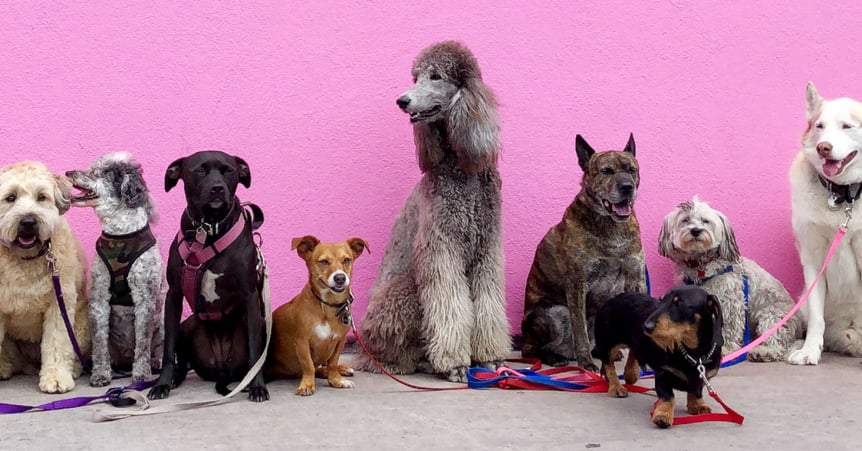
Dog cancer specialist Dr Clare Knottenbelt reveals the insights derived from studying and treating man's best friends.
Forward: features are independent pieces written for Mewburn Ellis discussing and celebrating the best of innovation and exploration from the scientific and entrepreneurial worlds.
Dog cancer should be bigger news. It's not merely that one in three dogs will get, and die from, cancer. It's the fascinating link between canine oncology and human treatment. The two are intertwined. Leads from one discipline easily spill over to the other. And at times it's the dog researchers leading the way.
Who better to give a whirlwind tour of canine oncology than Dr Clare Knottenbelt? She's arguably Europe's leading expert in the field. She was a top tier academic serving as professor of small animal medicine and oncology at the University of Glasgow. Today she's an entrepreneur involved with three companies. She started a specialist canine cancer consultancy called Hawk and Dove in 2019, helping veterinarians and pet owners navigate diagnoses and provide compassionate cancer treatment for pets.
She's also a director of a horse treatment centre, based on her father's work in equine cancer. “We treat 2,000 horses a year via an online portal. It started treating sarcoids, which is a form of equine skin tumour, and now treats any equine skin disease,” she says. The obsession with animal cancers runs in the family. “My father has spent 30 years on sarcoids. Our treatment isn't available anywhere else.”
The canine advantage
The frequency with which dogs get cancer is, sadly, helpful to researchers. Lobsters, by contrast, almost never get tumours. But dogs are afflicted by the full array.
The variation of cancers in breeds holds a special significance. “We know that certain breeds are predisposed to certain types of tumour,” says Knottenbelt. “A good example is flat coat retrievers, which in the UK have a very high prevalence of histiocytic disease, which is a really nasty tumour. When I worked in the oncology department we knew when a flat coat retriever came in it would likely be histiocytic disease. What is interesting is that Norwegian line of flat coats is notoriously low in that cancer. So there is a lot of work looking at the genes to try and identify the gene that is predisposing them to that particular cancer.”
Subtle differences between breeds, and lineages within breeds, help cancer researchers zoom in on culpable genes. “Interestingly, different breeds of dog are almost genetically identical,” she explains. “There's very little difference between a pug and a great dane. It's bizarre and impressive that humans have managed to breed such a wide variety of dogs with very, very similar genomes. The advantage of dogs over the human world is this similarity. When you've got a high prevalence of cancer in a dog breed you can hone down the genetic variations in the breed that might be associated with that prevalence.”
The rise of low-cost DNA sequencing is helping with this. Human research is taking the lead here, with services such as 23andMe and Nebula Genomics offering sequencing and analysis for around $190. More than 10 million people have taken the 23andMe test, creating a remarkable pool of genetic data. Currently the genetics approach is in its infancy. Single gene disorders such as alpha-1 antitrypsin and haemochromatosis are possible to identify, but correlating cancer to genes is complex. Even breast cancer, for which the BRCA1 and BRCA 2 genes are known to increase risk, there are more than 1,000 genetic variants in these genes alone meriting research. This innovation in human health can be extended to canine research.
And it's not just dogs. Cats offer insights in cancer genetics too. “Around one in three cats will get cancer,” says Knottenbelt. “But they have a different prevalence of certain tumours. In dogs, you get a disease called multicentric lymphoma, which is lymphoma involving all the lymph nodes. In cats you are more likely to get intestinal lymphoma.”

Subtle differences between breeds, and lineages within breeds, help cancer researchers zoom in on culpable genes.
Accelerated results
Another reason dogs are interesting in cancer research is their shorter lifespan. The adage that one human year equals seven years in a dog's life holds true. “Six months survival time for a dog is the equivalent of three and a half years in the human world. Because of the shorter life span you are able to assess survival rate quicker. The survival rate can be calculated after 50 per cent of your patients die of the disease within a period of time. So if you see 50 per cent dying at 12 months you can calculate your survival time from that. With humans you have to wait a lot longer to see whether the drug has made an impact.” These quicker test cycles allow for faster evaluation, hence dog trials moving faster. It's a key reason why canine oncology is species-leading.
Regulations offer another clue. The rules for canine oncology are strict, but at times more accessible than comparable human treatment.
It's not all upside. A feature of the dog oncology field is how hard it can be to get owners to volunteer their pets for a trial. “These animals are like their children,” says Knottenbelt. “It's more like paediatric research.”
The logistics are less simple. When a human gets cancer their world stops. Dog illness and death are viewed less sympathetically by employers. “I've had patients in my office crying because they can't take any more time off work to take their dog for treatment. I lost my own dog to cancer ten and a half years ago, and it changed my philosophy considerably. When you have a pet with cancer it goes beyond what you can do to treat the disease It's about the emotional burden it places on people. The logistical challenges of going backwards and forwards for the checks. It's about the costs, and the time.” Canine oncology, in her view, needs to be about much more than mere scientific research. It's a whole package.
The market potential
Knottenbelt would love to see canine research better known not merely by the wider scientific community, but investors too. There is thought to be a $250 million a year market for canine therapeutics. Pet health is big business, and researchers need to keep that in mind during their development.
She is an exponent of scientists mastering the nuances of intellectual property. She says, “I learned a little about IP when I was at the university, as any IP you develop there is generally owned by the university. IP is such an important subject. I think a lot of scientists don't understand the commercial significance of IP. It's seen as a bit of a burden. They just want to get on with the science.”
Understanding the value of IP can be a godsend. Her father built his horse treatment company using IP he developed, and then protected, initially with the University of Liverpool. “The University withdrew from his product,” says Knottenbelt, so he retained full rights as he developed the company. She learned from his experience. “I've always had knowledge of IP from that point of view.”
Understanding IP, if anything, allows scientists to be more devoted to their research, knowing their work is safe and protected. “A glance at my CV should tell you I'm not motivated by money,” she says, “because I worked in academia for a long, long time! But money makes the world go round and makes things possible.”
Despite the market potential, new treatments in oncology are rare – especially in canine oncology. Development of new treatments is expensive and often uncertain.
“It's impossible to know how many trials are being conducted today, as they are confidential,” she says. “There are ongoing trials for a drug that is already out, an intralesional product for mast cell tumours in dogs. It's a local treatment, rather than a systemic treatment like chemotherapy. I am not aware of any other new drugs coming out imminently”
Pet owners think of their dogs as family and will often go to any lengths to help them. A new canine cancer treatment would not only reward investors and advance oncology, but help save the lives of man's best friends.
Importance of effective treatment
Sarah Kostiuk-Smith comments:
Effective treatment options for when our companion animals get sick is so important, and certainly something close to my heart and that of my colleagues. As with any pharmaceutical product, it is important to think about protecting associated intellectual property as early as possible in the research and development process, and to continue thinking about it right the way through development, marketing, and beyond.
Written by Charles Orton-Jones
Julie specialises in the drafting and prosecution of patent applications with a particular emphasis on both organic and pharmaceutical chemistry. She has extensive experience of advising on infringement and validity issues, in particular providing Freedom-to-Operate searches and opinions. She also represents clients in EPO opposition proceedings and provides general advice to intellectual property, including international portfolio management, IP strategy and IP litigation.
Email: julie.carlisle@mewburn.com
Sign up to our newsletter: Forward - news, insights and features
Our people
Our IP specialists work at all stage of the IP life cycle and provide strategic advice about patent, trade mark and registered designs, as well as any IP-related disputes and legal and commercial requirements.
Our peopleContact Us
We have an easily-accessible office in central London, as well as a number of regional offices throughout the UK and an office in Munich, Germany. We’d love to hear from you, so please get in touch.
Get in touch

